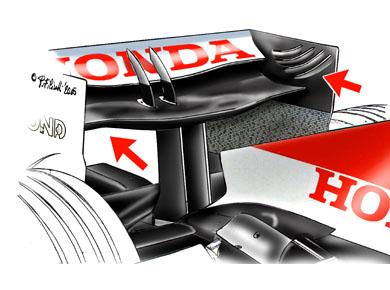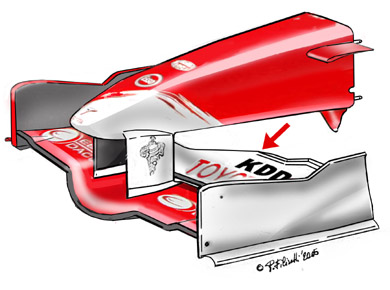Sunday, June 19, 2005
UNITED STATES GP 2005 TECHNICAL ANALYSIS
FIA FORMULA ONE CHAMPIONSHIP - UNITED STATES GP 2005
Turn 13 at Indianapolis is the only real banked turn in Formula One racing and proved Michelin's undoing. With an angle of up to nine degrees, it demands a left-right compromise on suspension set-up. The left tyres take the heaviest strain, particularly their shoulders, with tyre temperature increasing in this area as a result (red spot). If this temperature is too high for too long, wear rates rise dramatically and can lead to failure. The tendency for teams to run low tyre pressures, allowing them to use stiffer suspension settings, would only exacerbate the problem.
Jordan EJ15 - double splitter
Not entirely new, but an interesting feature at Indy. Just in front of the main splitter beneath the cockpit is an extra series of low barge boards (red arrow) with an almost V-shaped diverging profile joined by a horizontal plate. These elements work together with the horizontal turning vanes in front of the sidepods and the vertical sculpted shields at front-suspension level. They help manage airflow under the car, increasing downforce generated by the bottom of the car.
A completely new design for the US. The upper profile and flap feature a dished, V shape, which has proved more efficient in terms of top speed in testing, at the same time maintaining clean and efficient airflow at exit, so as to help with air extraction from the rear diffuser. New endplates sport four curved diagonal gills, similar to those introduced by Toyota at the start of the season. These reduce turbulence around the inner edge of the endplates.
This revised design is intended to reduce drag on the fast sections of the Indianapolis Motor Speedway. It features a narrower flap with a diagonal top profile (red arrow), reducing the cross section of the element (and hence drag) as much as possible. Single-lap performance has looked good - indeed, Toyota clinched their first ever pole in qualifying.
A revised flap for the US (right arrow), without the pointed extension (left arrow) seen in the recent races. Indy set-ups usually favour the track's high-speed section and this change indeed lessens drag and downforce. The lower section of the endplates are also newly rounded towards the rear to improve the wing's efficiency close to the front wheels.
The FW27's aerodynamics never stop evolving. For the US the rear of the sidepods have received particular attention, with interesting double winglets, the lower smaller winglet connected to the sidepod by a short horizontal link (left red arrow). This change is coupled with revised exhaust chimneys (right red arrow), designed to improve cooling in the infield section after the long run into turn 1.
Comments:
Post a Comment





